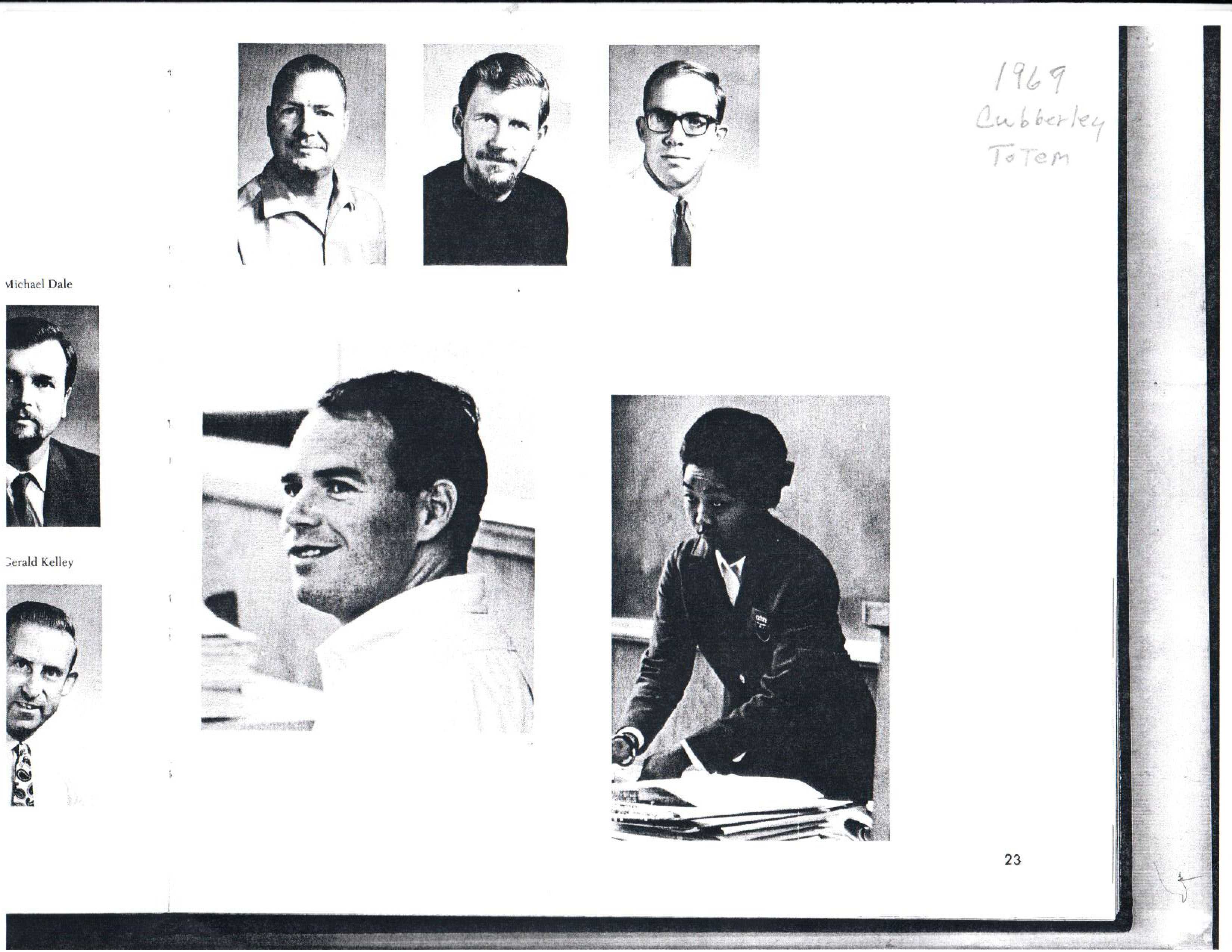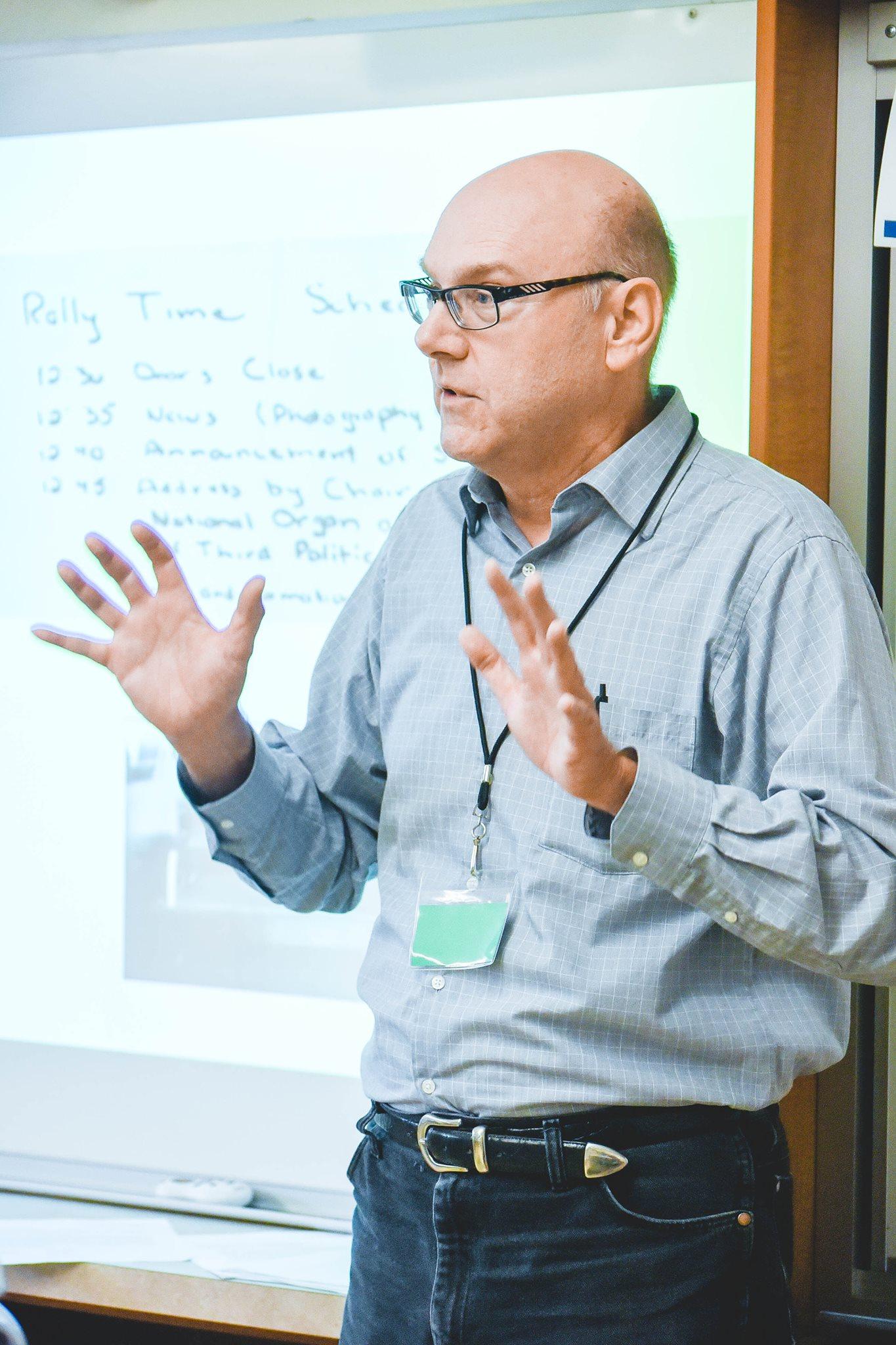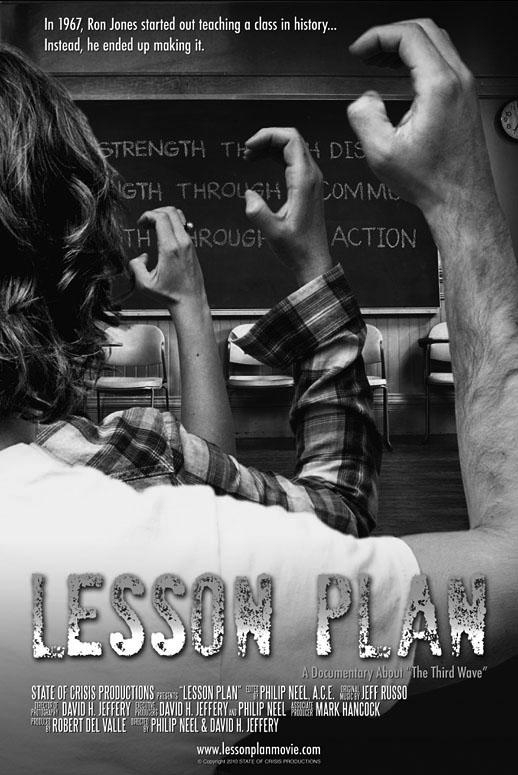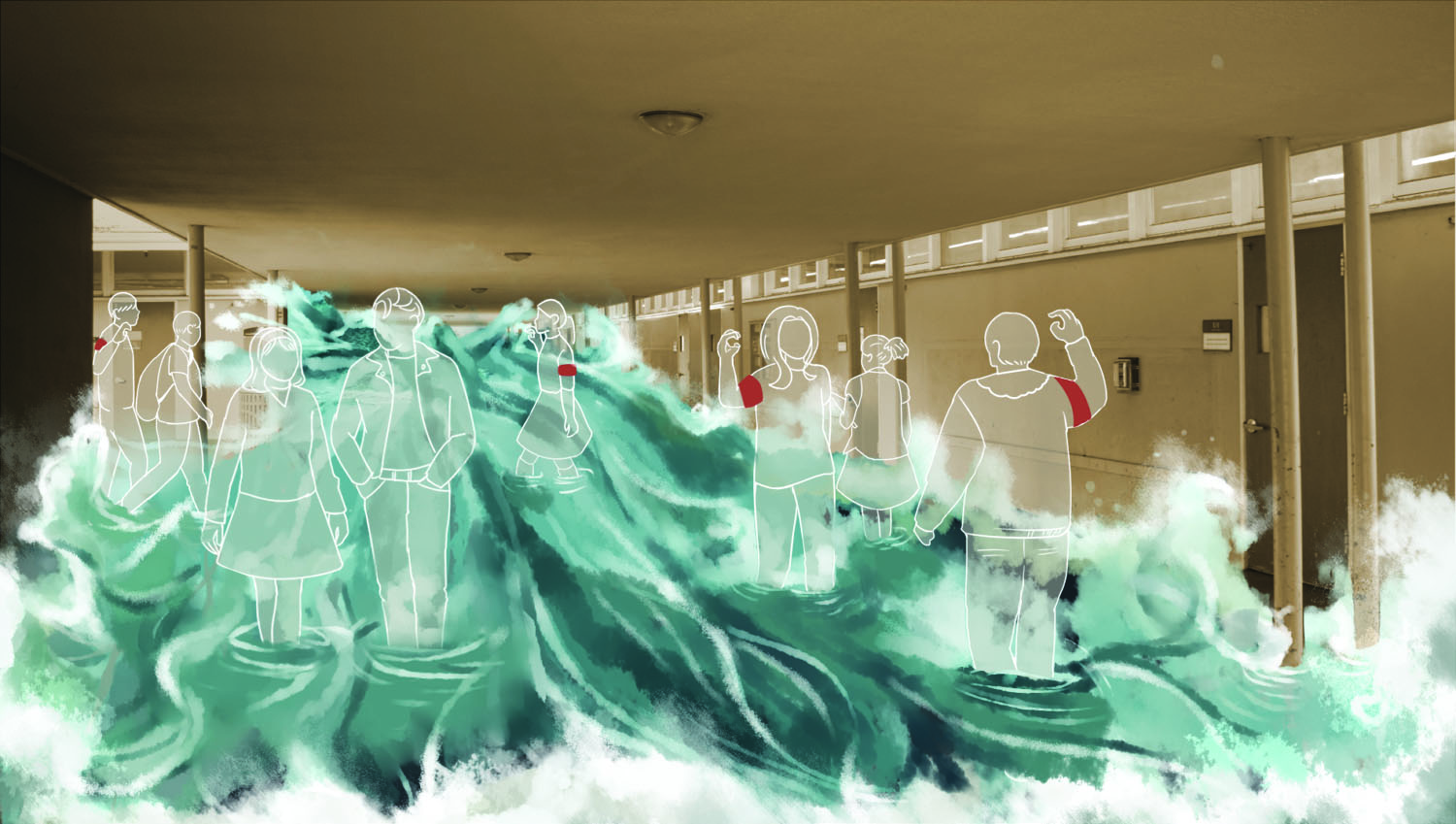“HE SCARES ME” — The Third Wave’s Ron Jones discusses his take-aways from the Third Wave experiment and his feelings about Donald Trump.
The Wave
Three high school students stand at strict attention with their backs straight and stiff, fists pounding on their chests, hands cupped in the shape of the letter “C.” They raise their hands toward the teacher, Mr. Ross, in reverence and duty. Ross shouts at three other students to stand, and they comply in a heartbeat.
The students chant, “Strength through discipline. Strength through community,” and Ross demands they shout louder.
More students join, standing from their desks, chanting and beating their chests. Passion and power seep through their deep cries — they unite as their voices rise from above the sounds of the chants and beats, their hands raised in a salute, their voices blending into an Orwellian proclamation of complete deference.
“STRENGTH THROUGH DISCIPLINE. STRENGTH THROUGH COMMUNITY.”
This eerie, “1984”-esque scene, an excerpt from the 1981 movie “The Wave,” depicts the rise to power of teacher at a suburban high school. The premise revolves around an experiment conducted nearly 50 years ago — in April 1967 — at Palo Alto’s own Cubberley High School. Mr. Ross is based on Contemporary World teacher Ron Jones, who was teaching a unit about Nazism during World War II.
Jones taught the unit as he traditionally would have — through lessons and lectures. However, his students were mystified as to how Hitler was able to rise to power and gain the support of so many Germans.

To give his students a better understanding of the evolution of Hitler’s regime, Jones created a lesson lasting one week that mimicked the conditions of living under a totalitarian dictator. The result of the experiment left an indelible mark on his class and in the fields of psychology and social science; professors and teachers far and wide still recount the lessons learned to their students all over the world. Millions of copies of “The Wave,” a novel by Todd Strasser recounting the experiment, have been sold internationally and are part of required curriculum in Germany.
“It’s actually one of the more memorable pieces of the curriculum,” says Scott Silton, a journalism advisor and history teacher at Aragon High School who teaches a unit on the Third Wave every year. “It’s something that … [I can] keep making reference to. There’s a reason why that many teachers keep choosing it over and over again, and it’s because the students respond to it, and that it’s a compelling story.”
The implications of the experiment are as potent and powerful today as they were in 1967, and extend far beyond the classroom. Jones, a beloved figure on campus, crafted a persona that bears similarity to many present political leaders, especially in today’s election season with Republican presidential candidate Donald Trump’s heated rhetoric over immigration, world-wide terrorism and race. (To hear Jones’ opinion of Trump, click here.) Through the “Third Wave” experiment, Jones demonstrated how easily charismatic leaders can create a cohesive following by instilling sentiments of exclusion and favoritism while playing on the fear of the public.
“I think you look to the political scene today — internationally, not just in the United States — and you see extremism, a simple answer offered by a religion or candidate to solve our problems,” Jones says. “I see fear and hatred being projected as answers to social problems as opposed to any sort of real solution.”
Groupthink in Experiment and Politics
The trusted teacher, who was known for his creative lesson plans, established strict rules that applied 24/7 — the students were required to wear arm bands, salute other students and Jones at every meeting, stand up to address Jones and report classmates who spoke against the “Wave.” Pitted against each other, Jones’ followers fell into the trap for much longer than he had anticipated; he had only meant for the experiment to be one day long, but was surprised when the students largely continued it themselves on Tuesday; then the small classroom experiment exploded into a school-wide movement. Students quickly assimilated into a tight-knit group and perpetuated the authoritarian-like regime that Jones had thrown together.
While the Jones’ instructions to the class were simple and seemingly unthreatening, the students’ grades were dependent on how well they obeyed Jones’ rules, leaving little space for disobedience. Dissent was not an option, and the threat of violence — perpetuated by a group of tough gangsters who Jones instructed to follow him around — created a cult-like atmosphere that peaked on the last day of the experiment, when Jones held a rally and announced that the Third Wave had been a mere demonstration. His ruse had succeeded; in fact, it had been far easier than Jones had predicted, demonstrating how quickly people can unite under a demagogic leader.


“This started as ‘You’re stuck in class, you gotta do what the teacher tells you, you find out the rules to get the grade and off you go,’” says Mark Hancock, one of Jones’ student at the time. “But after a while, this group became more and more coherent, more and more as a body of people. The whole group mentality of joining and belonging really set in.”
The few skeptics of the lesson were quick to be singled out and established as outcasts. Jones sent a young girl who voiced her doubt to the library, and barred her from returning to class for the remainder of the week, according to Hancock.
“If you said ‘I’m not sure I like this,’ or if you said that you wanted to exercise your civil rights, he would take you and throw you right out of the class,” Hancock says. “There was no free speech no freedom of assembly, no freedom of expression. You follow the party line or you are out.”
De Anza College professor of social psychology Laquisha Beckum explains that the behavioral principle of exclusion was a reason for the quick formation of Jones’ following.
“I think it’s really easy for us to form ingroups and outgroups,” Beckum says. “When we rely on authority in order to give us rules to follow, we come dependent on it, and so not only are you acting as an individual but you’re also acting because you see other people being OK with it.”
According to Beckum, this concept translates to the followers of contemporary presidential candidates. Voters are drawn in with the irresistible pull of inclusion and the need to feel a part of the loud majority.
“You’ll still have people who will work against it [authoritarian leadership],” Beckum says. “But the number of people who will back them and totally play into it become something of a crazy phenomenon, like the people backing Trump.”
A leader like Jones who pushes such divisions can employ charged rhetoric as a rallying point, says Benjamin Bolaños, a world history and sociology teacher at Palo Alto High School.
“‘Immigrants are taking our jobs.’ It’s a rhetoric that becomes real,” Bolaños says. “We say it over and over. And it has to resonate with people, too, as well. And I think that’s another part of it, too, with Trump: You’re saying things that may be untrue, but [it will still] resonate with people.”
In addition to his rules, on Thursday, the second to last day of the experiment, Jones told his students that the Wave was really a new American political party established in high schools all across America, and that the leader of this party would be revealed at a rally. This revelation sparked enthusiasm from his students. The next day, during a noon rally, Jones revealed a picture of Hitler to demonstrate how easy it was for Hitler to come into power. In the space of five days, Jones had utilized power and the obedience of his students to create a dictatorship of sorts, one in which students lost touch of their core values.
“The experiment showed this idea that you are more obedient to authority but also easily influenced by social and peer pressure,” Bolaños says. “You lose yourself in that larger collective identity.”
Jones’ mass following soon became an object of admiration from students outside of his class, who yearned for involvement, according to Hancock. It got to the point where students from other grades desired to be inducted into Jones’ class. This served to perpetuate the exclusion and creation of ingroups that Beckum suggests.
In Jones’ experiment, the distinction between these ingroups and outgroups were not drawn purely through indirect oratory — in addition to sending out students who dissented, Jones made it very clear that certain behaviors were frowned upon and held grave consequences if those rules were violated.
“He would make everyone sit at attention at these desks, and if you slouched, he would call you out on it,” Hancock says. “We began to develop as this sort of militant type of group.”
Fear-mongering
Bolaños says the passions and prejudices of the public are easily swayed and leaders can easily take advantage of this human characteristic to bait followers; the power that they wield and the rhetoric that they employ have the ability to create an imbalance that causes people to perceive their leaders with admiration, but also fear.
“We would have witch hunts in the classroom,” Hancock says. “Everyone was tattle-telling on each other. Jones would bring it [reports of students dissenting] in front of the class and say ‘Should they stay or should you go?’ And the class would chant ‘Go, go, go.’ Pretty soon that became a fever to take out people or abuse people.”
By singling out specific students, ordering students to follow a rigid set of rules and using language that encouraged staying within the collective group, Jones essentially forced students to go along with the experiment.
The tactics that he employed instilled an atmosphere of fear and mistrust in the students of one another, which left them with little choice but to support the cause.

While the experiment was an isolated case of a teacher instilling fear in his students, the experiment relates back to the broader idea of creating a sense of distrust and paranoia within a group of people.
“I think Donald Trump’s main tactic is instilling fear — of people who are different, and who people don’t generally know too much about,” says Paly junior Ashley Zhang. “Right now in America, Islamophobia is pretty prevalent, even in liberal places like California, because people aren’t educated about Islam, so they tend to believe whatever the media or their leaders tell them to.”
Assistant principal Kathleen Laurence, a former social studies teacher, says that Trump is one of the most prominent examples of leaders utilizing fear to gain followers. Laurence said that he fabricates a picture of minorities that supporters have no problem latching on to; by using hateful words and accusing minorities of causing a multitude of problems, Trump incites fright and tightens his grasp on the public.
“He’s very charismatic and so he draws people in,” says Laurence, who grew up in Palo Alto around the time of the experiment. “I think he preys on fears. What is his message? Most of times it’s how bad things are, not necessarily how to go about making them better.”
Beckum says that the use of fear to manipulate voters isn’t unique to Trump — the Democratic Party has also begun to employ similar tactics. They have often enticed voters by building up trepidation around the idea of Trump gaining the presidency.
“The message is that if you don’t vote for Hillary then it’s a vote for Trump,” Beckum says. “And they [the Democratic Party] are saying it over and over again. What this ends up doing is making people think that they don’t have a choice and that’s not true. … The DNC hasn’t generally been the fear-mongering party, but this presidential cycle there’s been a lot of that.”

Fear-mongering, as employed by leaders, unites people under common dislike or mistrust, deepening the already chasmic division between different groups in society. Leaders designate groups to point fingers at, and their followers willingly comply; according to Bolaños, it is so easy — so effortless — to project blame and negativity without thought to the consequences.
“We as a society express a lot of idealism; freedom, equality, diversity of opinion, diversity of culture and gender, but we do a terrible job of practicing it,” Bolaños says. “Individualism is embedded in our constitution… but we partake in something that destroys individualism and creates conformity.”
While fear runs rampant in our population and manifests itself through acts of violence, it also plagues the very leaders who induce it, according to Jones. Leaders are in a vulnerable position: They bear the responsibility of maintaining a positive public image and preventing missteps, but they also face the scrutiny of other leaders, who they feel threatened by.
“I’m shamed by this, but I liked the order, the discipline, the adulation, the power,” Jones says. “I became paranoid that others were going to take over. And that allows me to think about people like Trump or Stalin or Hitler who always try to exclude people they fear might take over that power.”
Fifty years after the experiment, Jones still fears the spread of hatred that he sees in leaders of the past and present. However, he believes that Americans can work to build immunity to stirring rhetoric and manipulative regimes, especially in the context of the looming election.
“Be yourself; be an artist; be a good family member; be a part of the democratic society, work to help the person up the street that needs care,” Jones says. “There are so many things we can do to make our world better, and not being a victim of making it worse.”
Related Stories
The Third Wave at 50 by Emma Cockerell and Stephanie Lee
Ron Jones: After the Wave by Emma Cockerell and Stephanie Lee
The Third Wave: Timeline of events by Emma Cockerell and Stephanie Lee
The Third Wave: Recognition in the Media by Emma Cockerell and Stephanie Lee
What Happens When We Accept Torture: Why the Stanford Experiment Still Matters by Julie Cornfield and Saurin Holdheim
The Details of the Stanford Experiment: What Really Happened by Julie Cornfield and Saurin Holdheim
Dear Grandma: Why Haven’t We Learned From the Past? by Noga Hurwitz
Connect with the Third Wave on Twitter by tweeting @toddstrasser and @thewavemark, or using the hashtags #thewave, #ronjones and #diewelle



